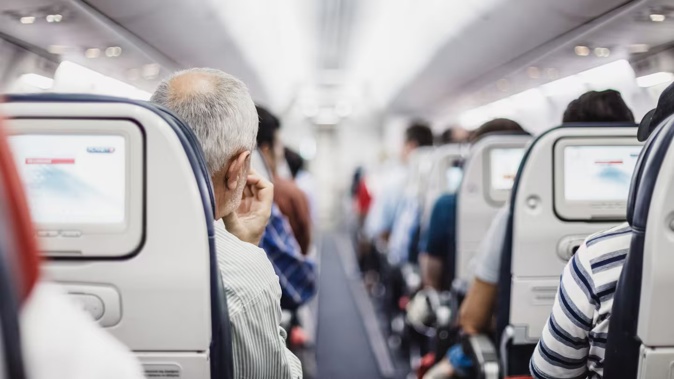
Even if you can ignore the sounds of crying babies and booming pilot announcements, aeroplanes can be loud. That’s usually due to another constant noise that you may not notice when settling into a long flight: the roar of the engines.
Despite advances in acoustic sound management, experts say this constant noise could be a source of discomfort and potentially even a risk to health and hearing. However, there is not much direct research on how aeroplane noise affects passengers.
“Thankfully, the noise levels passengers experience on most commercial aeroplanes are at safe levels,” Konstantina Stankovic, a professor of otolaryngology at Stanford University, said in an email. “However, sound levels can be uncomfortable and sometimes potentially harmful.”
Noise has health consequences
Loud sounds can damage the “delicate cells in the cochlea, which is the hearing organ” inside our ear, said Stankovic, who wrote a 2023 review on noise-induced hearing loss.
Sensory cells in our cochlea – called hair cells for the tiny filament-like structures protruding from the top of their cell surface – bend to the sound waves that hit our eardrums and translate them into electrical signals that are sent to auditory regions of our brain allowing us to hear.
Loud noise can physically damage the cochlea and overstimulate the sensory cells, which, if sustained over time, can harm or even kill them, leading to temporary or permanent hearing loss. Short bursts of extra-loud noise can also cause impairments.
Humans and other mammals are unable to replace these hair cells once they are damaged or lost. According to a 2024 study, approximately 1 in 5 Americans have hearing loss, which is a leading cause of disability. Research shows hearing loss is a preventable risk factor for dementia.
In addition, noise also has non-auditory health impacts including sleep disturbances, increases in hypertension and cardiovascular health, as well as cognitive impairment.
The discomforts of noisy flights
Inside an aeroplane cabin, the noise is typically around 75 to 85 decibels during flight, according to research studies that directly measured sound levels inside different passenger aircraft. During takeoff and landing, when the engines are most engaged, the sounds are often louder and can peak over 110 decibels at times.
For comparison, normal conversations are around 60 decibels.
However, the decibel scale used to measure sound levels is logarithmic, meaning that the amount of sound energy increases dramatically as we move up the scale. Every three-decibel increase corresponds to double the sound intensity reaching our ears.
On jet planes, passengers cite noise as the second most influential factor for discomfort, after legroom (or lack thereof). On smaller propeller aircraft, noise is the No. 1 factor for discomfort, “so it even has a larger impact,” said Gerbera Vledder, a graduate student of industrial design engineering at Delft University of Technology in the Netherlands who conducted a 2022 study on the matter.
If you are stuck in a noisy environment for a longer period of time, “you become more aware of other complaints” such as a stiff neck or swollen feet, Vledder said.
And research shows that people disembark more tired than if noise were not a factor, she said.
How much aircraft noise is safe?
In 1972, the National Institute for Occupational Safety and Health in the US set sound exposure recommendations of 85 decibels averaged over an eight-hour shift for workers. The Occupational Safety and Health Administration requires employers to protect workers’ hearing if noise exposure exceeds those limits as well.
However, emerging research calls for revising these recommendations “because the effects of noise exposure on hearing loss may be more severe than previously understood,” Stankovic said.
Some studies suggest people who work on commercial aeroplanes, such as pilots and flight attendants, could have increased rates of noise-induced hearing loss, though the results are not conclusive.
“I have to say there’s not a lot of research on the risks of hearing loss in aeroplanes,” Vledder said.
One 2014 study of more than 4000 flight attendants found that their self-reported hearing loss increased with time on the job. A 2018 study of 134 civilian pilots found they had worse hearing, especially for higher-frequency sounds, than people without that occupational noise exposure.
Though it is often cited for the public, using the industrial standard 85-decibel noise exposure limit is “always inappropriate,” Daniel Fink, programme chair of the Quiet Coalition, a programme of Quiet Communities, said in an email.
“It doesn’t protect workers from [noise-induced hearing loss] and safe exposure levels for anything need to be safer for the public than occupational exposures,” said Fink, who has written on the links between noise and hearing loss.
Research shows that even quieter levels of noise exposure – beneath the 85-decibel occupational recommendation – could impair hearing by altering how the auditory cortex processes sounds.
“Even lower levels of noise exposure, once deemed safe, can cause hearing damage over time” including making it more difficult to understand speech in noisy environments or tinnitus, Stankovic said.
In addition, some people may also be more susceptible to noise-induced hearing loss because of older age, genetic factors or pre-existing health factors, Stankovic said.
How to deal with noise on aeroplanes
Whether you want to be more comfortable or lower the risk to your hearing, there are several ways you can deal with aeroplane noise, experts said.
- Measure your sound levels. You can measure noise levels on a plane with a free sound meter app on your smartphone, such as the NIOSH Sound Level Meter, Decibel Pro or Decibel X.
- Sit near the front. Your seat location makes a difference. Seats near the aeroplane engines, which are typically on the wings or rear of the plane, tend to be louder, Stankovic said.
- Stay hydrated. Flying is dehydrating, so make sure to get adequate fluids. This “can alleviate discomfort, including ear pressure changes that may be worsened by noise,” Stankovic said.
- Try earplugs or headphones. Both can attenuate the amount of sound that reaches your eardrums, reducing the risk of harm and discomfort.
- One study found that having earplugs increased comfort – even when people did not use them. It could be that having a sense of control helped people feel better, Vledder said.
Of course, actually putting them on is a good idea. In a 2025 study, Vledder and her colleagues found that passengers who used either earplugs or headphones were more comfortable on propeller aeroplanes.
“I always use noise-cancelling headphones when I fly,” Fink said. “I recommend them for everyone, including children.”
However, Vledder noted that wearing headphones and earplugs can be their own source of discomfort in or around the ears.
“I do think it’s personal preference,” she said.
- Don’t turn up the volume. Don’t add to the problem by blasting more noise into your ears during the flight. In other words, be careful with how loud you play your music or movies, Fink said.
“I don’t think flying is safe for the ear,” Fink said. “Certainly not for cabin crew, and not for passengers either.”
Take your Radio, Podcasts and Music with you









